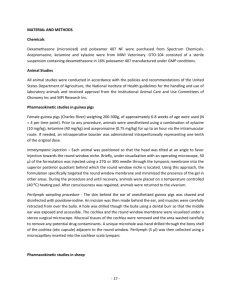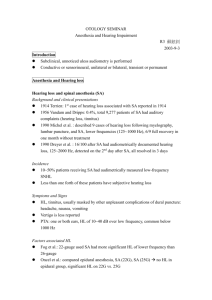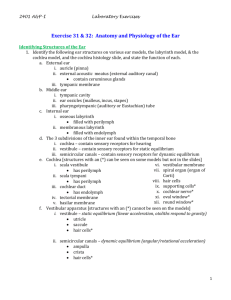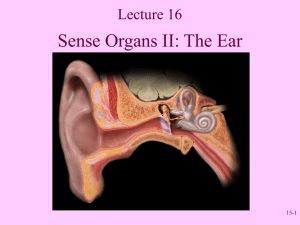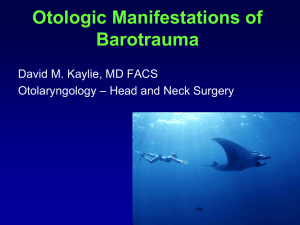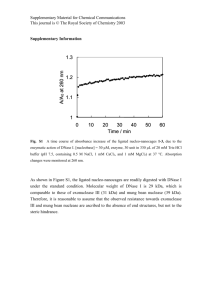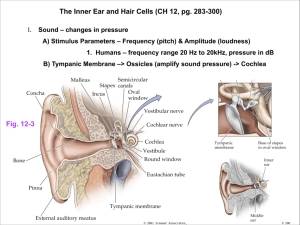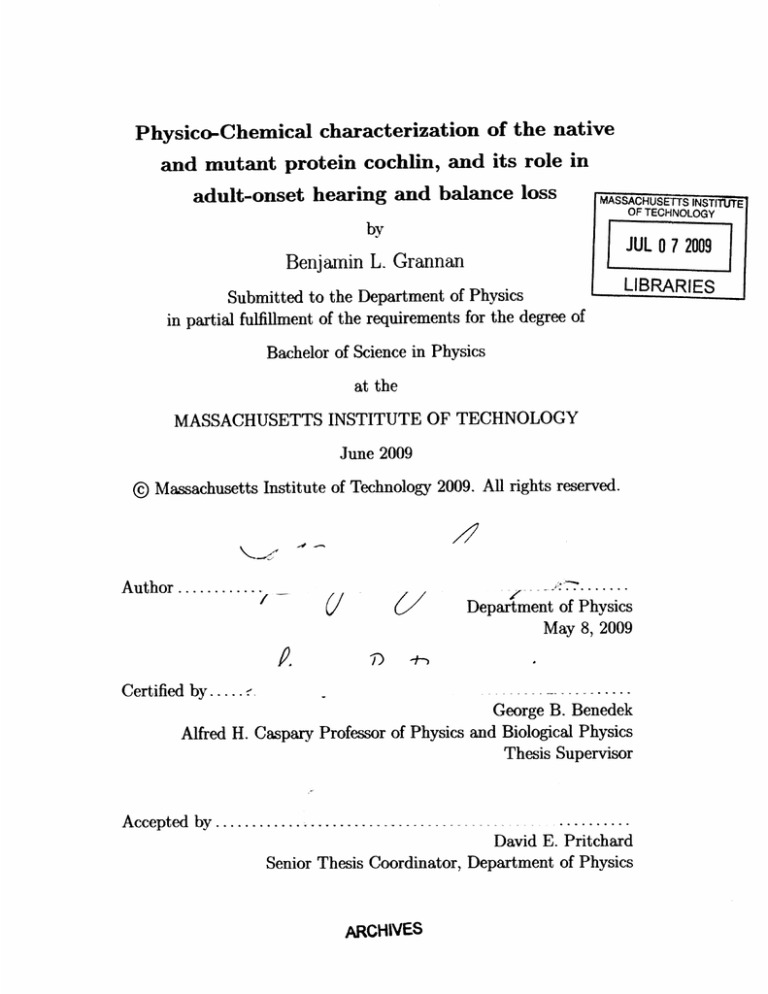
Physico-Chemical characterization of the native
and mutant protein cochlin, and its role in
MASSACHUSETTS
adult-onset hearing and balance loss
INSTIE
OF TECHNOLOGY
by
JUL 0 7 2009
Benjamin L. Grannan
Submitted to the Department of Physics
in partial fulfillment of the requirements for the degree of
LIBRARIES
Bachelor of Science in Physics
at the
MASSACHUSETTS INSTITUTE OF TECHNOLOGY
June 2009
( Massachusetts Institute of Technology 2009. All rights reserved.
A/
Author .........
V
Department of Physics
May 8, 2009
-1)
-t-b
-- --George B. Benedek
Alfred H. Caspary Professor of Physics and Biological Physics
Thesis Supervisor
Certified by ...... ,
Accepted by............
.....
...
...........
David E. Pritchard
Senior Thesis Coordinator, Department of Physics
ARCHIVES
Physico-Chemical characterization of the native and mutant
protein cochlin, and its role in adult-onset hearing and
balance loss
by
Benjamin L. Grannan
Submitted to the Department of Physics
on May 8, 2009, in partial fulfillment of the
requirements for the degree of
Bachelor of Science in Physics
Abstract
This thesis investigates the role of the protein cochlin and its isoforms in DFNA9 autosomal dominant late onset senorineural loss and vestibular disorder by quantifying
the concentration of cochlin in the inner fluid called perilymph. Through the use of
affinity chromatography, high performance liquid chromatography, the Bradford assay, western blot analysis, and proteomics analysis by mass spectroscopy, I acquired
data which suggests that the concentration of cochlin in the perilymph of bovine calf
ears is at most on the order of 10- mg/ml. I also determined the total protein concentration of native bovine perilymph to be 2.1+0.2 mg/ml. Additionally, I discuss
the theory of quasielastic light scattering along with its relevance to understanding
the role of cochlin in DFNA9.
Thesis Supervisor: George B. Benedek
Title: Alfred H. Caspary Professor of Physics and Biological Physics
Acknowledgments
I would first and foremost like to thank Professor Benedek for granting me the opportunity to take part in this research project. His mentorship and high standards
for excellence helped me to make the most of this outstanding learning experience. I
am confident that the skills I have acquired in Professor Benedek's laboratory, both
technical and intangible, will serve me well in my future years.
I also am much indebted to Dr. Jennifer McManus, Dr. Ying Wang, Dr. Aleksey
Lomakin, and Tayo Ogun whose advice and insight guided me in the lab and whose
friendship and humor made my research experience an absolute pleasure. I'd also like
to thank Nancy Robertson of Dr. Cynthia Morton's labortory at Harvard Medical
School who was extremely helpful in conducting the western blots reported in this
thesis.
Finally, I would like to thank my mother Mary, my father Greg, and brother Jake
who have supported me throughout my whole life in whatever challenges or endeavors
I have pursued.
Contents
1
Introduction
1.1
Background of DFNA9 .............
1.2
The COCH gene and cochlin isoforms .....
1.3
Anatomy of the inner ear ............
17
2 Methodology
Extraction of perilymph from bovine calf ears
..........
2.2
Anti-BSA affinity chromatography .......
. . . . . . . . . . 17
2.3
High performance liquid chromatography . . .
..........
2.4
Bradford assay
2.5
Western blot analysis ..............
2.6
Proteomics analysis by mass spectroscopy
2.7
Quasielastic light scattering ..........
.
. .
. . . . . .. . 20
. . . . . . . .
. .
. 21
. . . . . . 23
25
3.1
Removal of BSA from bovine perilymph
3.2
Total protein concentration measurements
3.3
Western Blots ..................
3.4
18
. . . . . . . . . . 19
.................
3 Results
4
17
2.1
3.3.1
Anti-p60 western blot ..........
3.3.2
Anti-p40 western blot ..........
Mass Spectroscopy ...............
Discussion and conclusion
. . .
. .
. .
.
. . . . . . 25
. . . . .
. 26
. .
. . . .
. 27
.
. . . .
. 27
. . .
..
. 29
. . . .
. 30
4.1
Discussion of results
4.2
Suggestions for future investigation . ..................
4.3
Conclusion ...................
...................
.......
35
36
...........
..
37
List of Figures
15
1-1 Structure of COCH gene and cochlin isoforms . ............
..
1-2 Anatomy of the inner ear .......
16
..........
.....................
..
26
3-1
Removal of BSA .......
3-2
SDS PAGE and p60 antibody western blot analysis ..........
28
3-3
SDS PAGE and p40-antibody western blot analysis ..........
29
10
List of Tables
3.1
Concentrations of perilymph samples. . ..................
27
3.2
Mass spectroscopy proteomics results . .................
33
12
Chapter 1
Introduction
1.1
Background of DFNA9
DFNA9 autosomal dominant hereditary sensorineural loss and vestibular disorder is
a genetic neurological disease which causes loss of hearing and balance in humans.
The age of onset for DFNA9 disease ranges from mid-thirties to early sixties and the
severity of symptoms can vary significantly from individual to individual, even among
those carrying the same mutant allele [1]. There have been eight genetic mutations
linked to the disease-seven missense and one in-frame deletion [2]. Each of these
mutations occurs within the COCH gene on chromosome 14q12-13 (DFNA9 locus),
making cochlin, the COCH gene protein product, the likely player in the mechanism
of disease [1].
Cochlin is one of the most abundant proteins present in inner ear tissues. Additionally, cochlin, which is a secreted protein, has been detected in the perilymph
fluid which is encapsulated by these same inner ear tissues [2][4]. Since cochlin is a
secreted protein and it is abundant in the inner ear tissue, it is reasonable to hypothesize that the concentration of cochlin is relatively high in the perilymph. Under this
hypothesis, a potential mechanism of disease would include the aggregation of mutant
cochlin around neuron endings in the inner ear, which in turn leads to hearing and
vestibular dysfunction.
Although cochlin has previously been detected in perilymph, its concentration
has not been determined.
In order to test the cochlin aggregation hypothesis, it
is first necessary to measure its concentration because it provides a physiological
reference point for comparing the in vitro aggregative properities of mutant and wildtype cochlin as a function of concentration. Any differences in aggregative properties
between mutant and wild-type cochlin will likely only be relevant to understanding
DFNA9 if they are observered within the physiological range of cochlin concentration.
In this thesis, I report the advances that I have made in determining the concentration of cochlin in the perilymph of bovine calf ears. I use western blot analysis to
confirm the presence of cochlin in perilymph. Next, I use proteomics analysis by mass
spectroscopy to quantitate the concentration of cochlin. However, the data acquired
from mass spectroscopy demonstrates that the concentration of cochlin in perilymph
is relatively low in contrast to its abundance in the inner ear. Finally, I also discuss
how future characterization of wild-type and mutant cochlin by use of quasielastic
light scattering (QLS) could provide insight into the mechanism of DFNA9.
In the following sections of the introduction I will familiarize the reader with the
COCH gene, the cochlin protein and its isoforms, and also the anatomy of the inner
ear. In the subsequent chapters I describe the methods that I have used in this
thesis, report my major findings, and provide a discussion of these results and their
implications for understanding DFNA9.
1.2
The COCH gene and cochlin isoforms
The structure of the COCH gene and the cochlin isoforms are drawn in figure 1-1.
The COCH gene codes for a signal peptide sequence and three domains: one Limulus
factor C cochlin late gestation lung protein (LCCL) domain and two von-Willebrand
factor A (vWFA) domains [3]. Cochlin exists in multiple isoforms that I will refer to
as p63 (full-length cochlin), p44, p40, and cochlin-tomoprotein (CTP). Ikezono et al.
reported the sizes of each human isoform to be 60-63 kDa, 44 kDa, 40 kDa, and 16
kDa, respectively. The size of the bovine CTP isoform differs from the human isoform
and has been reported as 18-23 kDa. The size variation results from transcriptional
SP
LCCL
vWFA1
vWFA2
p63
CTP
p4 4
p4 0
Figure 1-1: Structure of COCH gene and cochlin isoforms. Shown at top are the
major domains of the COCH gene-SP, LCCL, vWFA1, and vWFA2. The stars
signify the loci of the DFNA9-associated missense mutations [3]. The resulting protein
isoforms-p63, CTP p44, and p40-are shown below (red). They are horizontally
aligned with their respective coding regions of the COCH gene. The N-terminus of
each protein isoform is to the left and the C-terminus is to the right.
and post-translational modifications [4]. The signal peptide is a secretory signal that
directs the mRNA product to the rough endoplasmic reticulum where it is cleaved
prior to complete protein translation, thus having no effect on the ultimate peptide
sequence of cochlin.
As is indicated by the stars in figure 1-1, five of the six missense mutations linked
to DFNA9 are located in the LCCL domain. The other missense mutation is located
near the C-terminus of the vWFA2 domain[2].
1.3
Anatomy of the inner ear
The major anatomical components of the ear are shown in figure 1-2. The elements
which are pertinent to this thesis include the cochlea, vestibule, and the semicircular
canals which compose the bony labyrinth tubes of the inner ear. While the semicircular canals and vestibule are responsible for balance, the cochlea contains the
hair cells, which are responsible for hearing. Perilymph is contained within the bony
labyrinth [5]. Through immunohistological staining of inner ear cross sections, cochlin
has previously been detected in high abundance in the labyrinth tissues [2].
Semicircular canals
Vestibular nerve
Cochlear nerve
Pinna -
Cochlea
Vestibule
Eustachian tube
Figure 1-2: Anatomy of the inner ear. Image taken from [5]
Chapter 2
Methodology
2.1
Extraction of perilymph from bovine calf ears
PROTOCOL: Bovine calf skulls were delivered by Research 87 in Waltham, MA
approximately 5-8 hours postmortem. Upon delivery, the skulls were kept at 40C
until the extraction was performed in the following 2-4 hours. For each ear, the tissue
and bone covering the auditory canal was removed to gain sufficient access to the oval
window. Using a hypodermic needle (Popper and Sons) and syringe, the oval window
was perforated and the perilymph was removed from the labyrinth tissue. The color
of the extracted liquid varied from clear to light pink. Any bright red samples were
discarded because of the high level of blood contamination.
Following extraction, the samples were placed in microcentrifuge tubes and spun at
20,000 g for 30 minutes to spin down any cellular contaminants such as red blood cells.
The clear supernatent was decanted and filtered with 0.22 pm microcon (Millipore).
All filtered samples were pooled together and stored at 4C.
2.2
Anti-BSA affinity chromatography
Affinity chromatography is a preparative technique that is used to either remove or
purify a protein in solution. The protein solution is passed through a column filled
with a media containing immobilized antibodies with a specific binding affinity for a
protein in the solution. Here, I use a column containing agarose beads conjugated to
monoclonal rabbit antibodies raised against bovine serum albumin (BSA) to remove
BSA from native perilymph.
Since BSA is a major component of perilymph [6],
removal of BSA was a logical first step toward the isolation and purification of cochlin.
I will refer to perilymph treated with anti-BSA affinity chromatgraphy as "anti-BSA
perilymph."
PROTOCOL: Using the AKTAprime plus purification system (Amersham Biosciences), perilymph samples were loaded at 1 ml/min onto the XK 16 column (GE
Healthcare), which contained approximately 10 mL of a slurry consisting of rabbit
anti-BSA antibodies conjugated to agarose beads (Sigma-Aldrich). The perilymph
was passed through the column with a flow rate of 1 ml/min and the eluate was
collected.
The bound BSA was eluted from the column with 12 ml of 200 mM
Glycine/HC1 pH=2.2. The process was repeated with the collected eluate to remove
any residual BSA from the perilymph. The eluate was concentrated to the volume
initially loaded onto the column using 10 kDa Amicon Ultra-4 filters (Millipore).
2.3
High performance liquid chromatography
In order to analyze the protein size distribution of perilymph samples, I use size exclusion high-performance liquid chromatography (SEC-HPLC). SEC-HPLC consists
of passing perilymph through a column containing a porous media, which retards the
movement of proteins based on size. The retention time (RT) of an analyte, which is
defined as the elapsed time between sample injection and when the analyte elutes from
the column and passes through a UV spectrophotometer, is linearly related to the
logarithm of the analyte's molecular weight (MW) [7]. Calibration of the SEC-HPLC
uses proteins of known molecular weights and is based on the following relationship:
RT = -clln(MW) + c2
where cl and c2 are constants.
(2.1)
SEC-HPLC can also be used as a preparative technique whereby a larger volume
of protein solution is loaded onto the column and the eluate is collected in fractions.
I use preparative SEC-HPLC to seperate the major absorption peaks of anti-BSA
perilymph.
PROTOCOL: For analytical SEC-HPLC, 20 dl perilymph samples were injected
on the Superdex 200 10/300 GL size exclusion column (GE Healthcare). The Beckman
Coulter System Gold 126 solvent module and System Gold 168 detector were used to
perform each run. The running buffer was 0.1 M sodium phosphate buffer at pH 7.1.
Each run lasted for 60 minutes at a flow rate was 0.5 ml/min. The 32 Karat software
was used to conduct the run and to acquire the absorption data. For preparative
SEC HPLC, 500 pl of the protein solution is injected and the eluate is collected in
0.5 ml fractions. These fractions were pooled into four larger fractions as described
in the results section 3.3.
2.4
Bradford assay
The Bradform assay is a common method used to determine the concentration of total
protein in a given solution. It utilizes coomassie blue G250 dye which has a A=595 nm
absorption peak when bound to the side chains of lysine and arginine. To conduct the
assay, a calibration curve is first generated using mixtures of the coomassie Bradford
reagent and known concentrations of immunoglobin G (IgG). The calibration relates
linear light absorption at A=595 nm and protein concentration in a linear fashion.
By measuring the A=595 nm absorption of native and anti-BSA perilymph with the
Bradford reagent, I am able to determine the total protein concentration of both
samples within a 10% relative error.
PROTOCOL: 100 mg Coomassie Brilliant Blue G-250 (Biorad) was dissolved in
50 ml of 95% ethanol and then mixed with 100 ml of 85% (w/v) phosphoric acid.
The solution was then diluted to 1 L with distilled water and filtered with Whatman
#1 paper. 100 pl of IgG (Sigma-Aldrich) aliquots ranging from 0.05 mg/ml to 1.0
mg/ml were mixed with 5 ml of the filtered reagents. The samples were incubated at
25°C for 5 min. Absorption at A=595 nm for each of the IgG standards was recorded
and used to produce a calibration curve. The measurement was repeated with the
native and anti-BSA perilymph. Their respective total protein concentrations were
calculated using the generated calibration curve.
2.5
Western blot analysis
To detect cochlin isoforms in perilymph, I use immunodetection by western blot.
The proteins in perilymph are first seperated based on size by sodium dodecyl sulfate polyacrylamide gel electrophoresis (SDS PAGE). Next, the electrophoresed protein is transferred from the polyacrylamide gel to a polyvinylidene fluoride (PVDF)
membrane, which is then probed with cochlin-specific antibodies (primary antibody).
Binding between the antibody and protein is visualized by using secondary antibodies
that bind to the primary antibodies and produce a chemiluminescent signal.
I performed the western blots which are reported in this thesis with Nancy Robertson of Dr. Cynthia Morten's laboratory at Harvard Medical School. The two different
anti-cochlin antibodies that I used were raised by Dr. Tetsuo Ikezono of Nippon Medical School in Tokyo, Japan. I will refer to them as "anti-p60" and "anti-p40." The
anti-p60 was raised against the 18 amino acid peptide sequence composing the Nterminus of the LCCL domain. The anti-p40 was raised against the 19 amino acid
peptide sequence composing the N-terminus of the vWFA2 domain. Therefore, antip60 binds to the p63 and the CTP isoforms while the anti-p40 binds to the p63, p44,
and p40 isoforms. More detail on peptide synthesis can be found in Ikezono et al [9].
PROTOCOL: For SDS PAGE, two NuPAGE 10% Bis-Tris gels (Invitrogen) were
used. The wells were loaded with 20 pl of protein sample, 8 pl of loading buffer, and
3.5 p[ of the reducing agent as prescribed by the manufacturer's protocol. The gel
was electrophoresed for 35 minutes at 200 volts. One gel was visualized by coomassie
staining while the other was used for protein transfer to a PVDF membrane. The
transfer took place at 40C for 1 hour at 30 volts. The membrane was rinsed with
blocking buffer overnight to prevent non-specific antibody binding to the PVDF.
Next, the membrane was rinsed with the primary anti-p60 or anti-p40 antibody for
two hours, then four times with PBST for 10 minutes each, followed by the secondary
antibody (anti-IgG conjugated with horseradish peroxidase) for 1 hour, and finally
four times with PBST for 10 minutes each. The antibody binding is visualized using
ECL-Supersignal West Femto Maximum Sensitivity Subtrate.
2.6
Proteomics analysis by mass spectroscopy
To determine the protein content of the anti-BSA treated perilymph sample, I submitted the sample for mass spectroscopy, which was conducted by by Ross Taimano
at the Taplin Mass Spectroscopy Facility at Harvard Medical School. The particular mass spectroscopy technique that was used is referred to as LC-MS-MS, where
LC stands for liquid chromatography and MS stands for mass spectroscopy. The
sample is first treated with the proteolytic enzyme trypsin, which digests peptide
bonds following lysine and arginine residues. The resulting fragments are seperated
by HPLC. Upon eluting from the HPLC column, the fragments are ionized and the
first mass spectroscopy measurement is acquired. Next, the detected peptides are
bombarded with high energy electrons which cause further fragmentation and ionization. The second round of mass spectroscopy detects this spectrum of fragmentation.
By comparing the initial fragment mass and the subsequent fragmentation pattern to
a protein database, the peptide sequence can be determined. From the the compilation of the many detected peptide sequences the protein composition of the original
sample is deduced.
Although this type of proteomics analysis is primarily used to determine the major protein components of a sample, here I develop a method for estimating the
concentration of each detected protein. Each unique peptide sequence i detected for
a particular protein j has an associated intensity value Ii which is proportional to
the number of times the unique sequence is detected. The average intensity I~ for
each detected protein can be taken as the average of the Nj unique peptide intensities
matched to protein j:
i=
NjY
i
(2.2)
1 i=1
Calculating the average intensity is necessary because some peptide sequences are
more susceptible or resistant to ionization and fragmentation than others. The molar
fraction (Xj) of each protein is assumed to be equal to (1j) divided by the sum of the
average intensities of all M proteins:
Xj=
I-
(2.3)
The masses of each detected protein (mj) is predicted from its amino acid sequence
(Uniprot.org). With (mj) and Xj known for all detected proteins, the concentration
of a detected protein (C) is given by:
,
=
Xmi
j--1 Xjmj
C
(2.4)
where C is the total protein concentration of the analyzed sample. It is important to
note that this calculation assumes that the detected proteins compose 100% of the
total protein concentration. In theory, this may cause a slight overestimate of each
individual protein concentration.
PROTOCOL: 500 pl of anti-BSA perilymph (1.3 mg/ml) was concentrated to 100
pl (6.5 mg/ml). This sample was submitted for mass spectroscopy. Ross Taimaino
reported that approximately "half" of the sample was lost due to clogging of the
HPLC during the initial run. The recovered half of the sample was used for the
reported proteomics results. Since the calculation normalizes the molar fractions of
each protein, the loss of sample only affects the intensity of the detected peptide
fragments and not their calculated concentrations.
2.7
Quasielastic light scattering
Quasielastic light scattering (QLS) is an effective method for determining the diffusion coefficients of macromolecules in solution. The diffusion coefficient of a particle
undergoing Brownian motion is related to its molecular size and shape. Therefore,
a protein which aggregates or exists in an equilibrium of polymerization states will
produce a distribution of diffusion coefficients when studied by QLS. Using this distrubition of diffusion coefficents, the self-assembly and aggregation of a protein solution
can be characterized. Due to time constraints, I did not conduct any QLS measurements in this thesis. However, I describe the theory of QLS in this section, and I
later comment in chapter 4 on the relevance of future QLS measurements may have
to understanding the mechanism of DFNA9 disease.
In essence, the technique consists of irradiating a solution of macromolecules with
a coherent beam of light and detecting the intensity of scattered light over time. The
theory, as is discussed by Lomakin et al.[8], is as follows:
Each particle k at position vector r' produces a scattered electromagnetic wave
Ek = IEklexp(iq. r' + iq), where q'is the scattering vector and q is the common phase
shift. The intensity of scattered light (I) is proportional to the square of the total
electromagnetic field scattered by all N particles:
N
I= IEk I 2
k=1
(2.5)
To relate the intensity of scattered light to the diffusion coefficient it is necessary to
first define two correlation functions as follows:
GI(T) =< I(t)I(t + T) >
(2.6)
GE(T) =< E(t)E(t + T) >
(2.7)
where I(t) and E(t) are the intensity and electric field of the scattered light at time t
and where the angle brackets signify a time average. These two correlation functions
are related by the following equation:
GI(7) =< I >2 (1 +
2
ygE(7)
)
(2.8)
where < I > is the average intensity, y is the efficiency of light intensity detection,
and gE(T) = IGE(T)/GE(O)I. The correlation function gE(T) can finally be related to
the diffusion coefficients (Dz) of the particles in solution:
zIexp(-Dzq27)
gE(T) =
(2.9)
z
where I_ is the normalized, fractional intensity that results from the particles with
diffusion coefficient Dz.
The hydrodynamic radius of a particle (Rh) is equivalent to the radius of a sphere
which would exhibit the same diffusion coefficient in solution. It is generally a good
indicator of particle size and can be calculated from the diffusion coefficient as follows:
Rh =
kBT
67rTID
(2.10)
where kB is the Boltzmann constant, T is temperature in Kelvin, and 7j is the solution
viscosity.
Chapter 3
Results
3.1
Removal of BSA from bovine perilymph
The SEC-HPLC chromatograms of native and anti-BSA perilymph are shown in
figure 3-1. According to the molecular weight calibration scales shown below the
retention time axes, any cochlin p63, p44, and p40 isoforms present in the samples
likely elutes at a retention time ranging from 28 to 31 minutes (peak 2). BSA has a
molecular weight of 66 kDa and also elutes in this range. By comparing the absorption
peaks between retention times of 24 and 36 minutes (shown in the right column of
chromatograms), we see that peak 2 of the anti-BSA perilymph has decreased height
and area with respect to peaks 1 and 3 in comparison to the native perilymph sample.
This indicates that BSA was removed from peak 2. It is important to note that the
absorption axes for the native perilymph samples have a much smaller range than the
absorption axes for the anti-perilymph samples. This is because the native sample
was an analytical HPLC (20 1l injected) while the anti-BSA sample was a preparative
HPLC (500 1l). For the purpose of identifying the removal of BSA, it is only necessary
to compare relative absorption values.
The native perilymph also shows high absorption peaks at a retention time of 47 to
51 minutes (peak 4) which corresponds to small protein fragments of less then 5 kDa
in size. This peak vanishes in the anti-BSA perilymph due to the reconcentration step
with 10 kDa filters, which allows any molecules less than 10 kDa to pass through the
membrane into the filtrate. Therefore, the decrease in total protein concentration as
reported in section 3.2 results from the removal of both BSA and these small protein
fragments in peak 4.
native perilymph
60
native perilymph
4
50
2
5
E 40
5
o 10
30
.
2
N 20
<:10
1
0
5
10
15
20
25
,.0=
o
3
30
I' IO
3
_
35
40 45
50 55
60
22
24
26
28
30
32
Retention Time (min)
Retention Time (min)
Molecular Weight (kDa)
Molecular Weight (kDa)
anti-BSA perilymph
2000
1,
34
36
34
36
anti-BSA perilymph
600
- 500
1500
E 400
1000-
5 300
2
u
3
1
0
0 200
5
10 15
20
25
30
35
<
4
40
45
Retention Time (min)
Molecular Weight (kDa)
Molecular Weight (kDa)
50 55
60
3
100
20
22
24
26
28
30
32
Retention Time (min)
Molecular Weight (kDa)
Figure 3-1: Removal of BSA from Perilymph. The complete SEC-HPLC chromatograms (retention time 0 to 60 min.) for native perilymph and anti-BSA perilymph are shown in the left column. The chromatgrams in the right column provide
a closer view of the absorption peaks at retention times of 20 to 36 minutes. Both retention time and molecular weight horizontal axes are shown. The major absorption
peaks are numbered 1 through 4.
3.2
Total protein concentration measurements
Using the Bradford assay described in section 2.4, the total protein concentration
of native and anti-BSA perilymph were measured to be 2.1±0.2 mg/ml and 1.3±0.1
mg/ml, respectively. These results are shown in table 3.1.
By comparing these
values with the SEC-HPLC chromatograms, it is clear that the difference in total
protein concentratio between the two samples results from the removal of BSA and
small protein fragments (less than 5 kDa) from the native perilymph. The individual
contributions to this concentration reduction by the BSA removal and the small
fragment removal cannot be quantified since the extinction coefficients of the small
fragments are unknown.
Sample
Native Perilymph
Anti-BSA Perilymph
BSA + small fragments
Concentration (mg/ml)
2.1 ± 0.2
1.3 ± 0.1
0.8 + 0.1
Table 3.1: Concentrations of perilymph samples. This table reports the concentrations of native, anti-BSA perilymph, and the BSA plus small fragments removed from
native BSA.
3.3
3.3.1
Western Blots
Anti-p60 western blot
Figure 3-2 displays the western blot performed with the anti-p60 antibody. The
protein samples loaded into each lane are as follows:
Lane
Content
1
BSA (0.2 mg/ml)-Neg. Control
2
Hemoglobin (0.2 mg/ml)-Neg. Control
3
Native perilymph (0.5 mg/ml)
4
Anti-BSA SEC-HPLC fraction 4
5
Anti-BSA SEC-HPLC fraction 3
6
Anti-BSA SEC-HPLC fraction 2
7
Anti-BSA SEC-HPLC fraction 1
The BSA and hemoglobin samples functioned as negative controls. The anti-BSA
SEC-HPLC fractions consist of the eluate fractions collected from the preparative
HPLC-SEC performed on the anti-BSA sample (see figure 3-1). Fractions 1, 2, 3,
kDa
191-
std.
1
2
3
4
5
6
7
kDa
191-
97-
97-
64
64-
51 -
51-
39-
39-
1
2
3
4
5
6
7
282828I
14-
-11
(A)
I
"M"=I
him,-- amm gmAl
(B)
Figure 3-2: SDS PAGE (A) and p60 antibody western blot analysis (B).
and 4 correspond to protein collected during retention times of 1-20 min, 20-27 min,
27-31 min, and 31-60 minutes. Therefore, peak 2 which contains any p63, p44, or
p40 isoforms is present in fraction number 3. According to the HPLC calibration,
the CTP isform (18-23 kDa) would be in fraction 4. Relative to the native protein
loaded in lane 3 the anti-BSA SEC-HPLC was approximately 4-5 times more dilute.
The protein concentrations of these samples were not measured using the Bradford
assay.
In the SDS PAGE we see protein bands in the native perilymph and in the antiBSA SEC-HPLC fraction 3. The major differences between these bands is the removal
of BSA and the decreased protein concentration of the the SEC-HPLC anti-BSA
fraction 3.
The western blot shows anti-p60 binding to full length cochlin at a molecular
weight approximately 60 kDa. However, there is no binding observed in the anti-BSA
SEC-HPLC fraction 3. This suggests that the concentration of p63 cochlin in lane
5 is below the detection limit of the western blot. There is significant binding in
lanes 2 through 5 in the 14 to 30 kDa region despite the corresponding regions of the
SDS PAGE. This suggests the presence of the CTP cochlin isoform. Since there is
some overlap between peaks 2 and 3 in the anti-BSA SEC-HPLC chromatogram, it
is possible that CTP is present in both anti-BSA SEC-HPLC fractions 3 and 4. This
may have led to the extemely strong chemiluminscent signal. Ikezono et al. reports
significant binding of the anti-p60 to native bovine perilymph in this range as well [9].
3.3.2
Anti-p40 western blot
Figure 3-3 displays the western blot performed with the anti-p40 antibody. The
protein samples loaded into each lane are as follows:
Lane
std. 1
kDa
Content
1
Native perilymph (0.1 mg/ml)
2
Anti-BSA perilymph (0.1 mg/ml)
3
Native perilymph (1.0 mg/ml)
4
Anti-BSA perilymph (1.0 mg/ml)
5
Hemoglobin (2.0 mg/ml)-neg. control
6
BSA (2.0 mg/ml)-neg. control
2 std. 3
5
4
6
std.
kDa
191 -
191-
97-
97-
64-
64-
51-
51-
39-
*
2
3
5
4
6
39-.
28-
28-
14
14(A)
1
.
(B)
Figure 3-3: SDS PAGE (A)and p40-antibody western blot analysis (B).
In the SDS PAGE image we see the expected protein staining pattern of perilymph
with the majority of the protein approximately 50-80 kDa in size. By comparing lanes
1 with 2 and 3 with 4 we see that BSA is clearly being removed through the anti-BSA
affinity chromatography step because there is significantly less coomassie staining at
66 kDa in the anti-BSA perilymph than in the native perilymph.
The western blot shows a large amount of non-specific binding.
Both of the
negative controls fail (lanes 5 and 6) and there is binding in 65 to 95 kDa range
in both the native and anti-BSA concentrated samples (2.0 mg/ml). The anti-p40
antibody should only recognize p63, p44, and p40 cochlin isoforms. Despite the
non-specific binding, lanes 3 and 4 do show a thin band around 45 kDa which may
correspond to the presence of either the p44 or p40 isoform. The less concentrated
samples in lanes 1 and 2 do not show these bands which suggests that the protein
concentration is likely below the detection limit for the anti-p40 antibody. However,
due to the widespread non-specific binding by the anti-p40 antibody it is difficult to
make any firm conclusions from this western blot.
3.4
Mass Spectroscopy
The proteomics results of the anti-BSA perilymph sample are reported in table 3.2.
The table lists each detected protein with its corresponding reference number, number
and average intensity of the unique peptides detected, molecular weight (as estimated
by the amino acid sequence), and estimated concentration. The calculation of protein
concentration is described in section 2.6.
The most abundant proteins in the sample are complement C4 precursor and
the neurofilament light chain. Hemoglobin a, hemoglobin /, and fetal hemoglobin
are also major components. However, no cochlin peptide sequences were detected.
This suggests that the cochlin concentration in the initial sample was below the
detection limit of this mass spectroscopy analysis. Although it is not possible to
directly estimate the concentration of cochlin since it was not detected, it is possible to
use the estimated concentrations of other detected proteins to determine the order of
magnitude of the upper limit of cochlin concentration in perilymph. Parkinson disease
protein 7 homolog and enolase 2 were found to have the lowest concentration-0.003
mg/ml. The cochlin concentration must be less than this value. Only one unique
peptide sequence was detected for each of these proteins which reduces the reliability
of the result. Apolipoprotein A-II was found to be at a concentration of 0.004 with
two unique peptide sequences detected.
This provides more reliable evidence for
concluding that the cochlin concentration in the anti-BSA sample is below 0.003-0.004
mg/ml. Assuming that no cochlin is lost during anti-BSA affinity chromatography,
this data suggests that the cochlin concentration is below 0.003-0.004 mg/ml in native
perilymph as well.
It should also be mentioned that the high level of hemoglobin subunits detected
suggests that the sample may have blood contamination. However, hemoglobin units,
along with other detected proteins such as apolipoprotein A-II, apolipoprotein C-III,
transferrin, and tubulin have been previously detected in human perilymph by 2D-gel
electrophoresis [10].
Table 3.2
No. Unique
Molecular
Average
Estimated
Protein
Ref. No.
Peptides
Weight (kDa)
Intensity
Conc. (mg/ml)
Alpha-2-HS-glycoprotein
gi 112909
1
38.4
5.5 x 10 5
0.009
Apolipoprotein A-II
giJ114052298
2
11.2
8.4 x 105
0.004
Apolipoprotein C-III
gij78099960
2
10.7
1.3 x 106
0.006
Chromagranin-A precursor
giJ116548
7
50.0
1.2 x 106
0.02
'Coagulation factor II
giJ27806947
1
70.5
2.4 x 106
0.07
'Coagulation factor II
giJ135806
1
70.5
3.5 x 106
0.1
giJ124056491
2
187.3
8.5 x 105
0.06
giJ31563307
2
101.9
2.7 x 106
0.1
Complement C3 precursor
Complement C4 precursor
Creatine Kinase
p chain
5
gi175060960
1
42.7
4.3 x 10
0.007
Enolase 1
giJ87196501
3
47.3
2.8 x 106
0.05
Enolase 2
giJ155371977
1
47.3
5.8 x 105
0.003
Hemoglobin a
gi 13634094
9
15.2
4.7 x 106
0.03
giJ122572
8
16.0
1.1 x 107
0.07
gij122544
5
15.9
9.4 x 106
0.06
Hemoglobin
f
Hemoglobin fetal
Continued on next page
'Coagulation factor II protein was reported twice for these proteins under different reference
numbers. This is likely due to multiple protein isoforms with slight variations in trypsin digest
products.
Table 3.2 - continued from previous page
No. Unique
Molecular
Average
Estimated
Peptides
Weight (kDa)
Intensity
Cone. (mg/ml)
1
101.5
2.9 x 105
0.01
giJ119917128
101.5
5.9 x 105
0.02
MAPT
gi181673830
46.3
0.01
MAPT
giJ135383
46.3
0.008
gi]119922061
191.5
0.04
gi 119922061
112.5
0.02
Neurofilament light
gi127806523
62.6
Neurofilament medium
gij143811427
103.2
0.03
3
Nucleobindin-1
giJ76607797
53.9
0.01
Osteoglycin
gij129077
34.2
0.02
gi175040204
20.0
0.003
Plasminogen
gij27806815
92.2
0.02
Proline-rich transmembrane
gij115496119
41.8
0.006
gij27807175
22.6
9.7 x 105
0.009
Prothymosin a
gi 158515409
12.1
5.7 x
0.003
Secreted phosphoprotein 1
giJ27806401
30.9
1.0 x
0.1
Secretogranin-1 precursor
giJ12644006
73.3
3.4 x
0.01
Serum amyload-1 precursor
giJ115497340
14.5
5.3 x
0.03
SPARC-like 1
giJ77735557
74.9
1.2 x
0.04
gij164414726
5.1
2.3 x
0.005
gij2501351
77.8
8.5 x
0.03
Protein
Ref. No.
Inter-alpha-inhibitor H4
gi1122140331
heavy chain 4
Inter-alpha-trypsin
inhibitor heavy chain 4
2
2
Myasthenia gravis
auto-Ag
3
2
Neurofilament heavy
Parkinson disease protein
0.1
7 homolog
protein 3
Protein phosphatase 1
regulatory subunit 1B
Thymosin
Transferrin
f 1
Continued on next page
2
MAPT was reported twice for these proteins under different reference numbers. This is likely
due to multiple protein isoforms with slight variations in trypsin digest products.
3
These proteins were reported as bovine proteins "similar" to human proteins in the database.
The molecular weight for the human protein is used since there was no database entry for the bovine
protein.
Table 3.2 - continued from previous page
No. Unique
Molecular
Average
Estimated
Peptides
Weight (kDa)
Intensity
Conc. (mg/ml)
1
61.1
5.1 x 105
0.01
gij168804008
50.2
1.9 x 106
0.04
Tubulin p chain 2
giJ51491829
50.1
9.7 x 105
0.02
f chain 2
gij77736271
50.0
4.2 x 105
0.009
8.0 x 107
1.3
Ref. No.
Protein
3
Transmembrane achor protein
7
gij119912 87
1 isoform 2
Tubulin a ubiquitous chain
Tubulin
Total
1
108
Table 3.2: Mass spectroscopy proteomics results. This table lists all proteins in the
anti-BSA perilymph sample that were detected by mass spectroscopy. The reference
number is the accession code for the matched protein in the protein database. The
number of unique peptides provides the total number of unique peptide fragments for
that particular protein. The average intensity is the average reported intensity for
all unique peptide fragments detected. Also listed is the calculated molecular weight
of each protein (UniProt.org) and the estimated individual protein concentration of
each protein.
3
These proteins were reported as bovine proteins "similar" to human proteins in the database.
The molecular weight for the human protein is used since there was no database entry for the bovine
protein.
34
Chapter 4
Discussion and conclusion
4.1
Discussion of results
The results of my thesis show that the concentration of cochlin isoforms in bovine
perilymph may be lower than initially hypothesized. By using mass spectroscopy to
detect the relative amounts of the major protein components in the anti-BSA perilymph and by using the Bradford assay to determine the total protein concentration
in the anti-BSA sample, I estimate the cochlin concentration to be no more than 10- 3
mg/ml. Since mass spectroscopy did not detect cochlin, this value is an estimation of
the mass spectroscopy detection limit, which provides an upper limit esttmate of the
possible range of cochlin concentration. I also estimate the total protein concentrations of native bovine perilymph and anti-BSA perilymph to be 2.1+0.2 mg/ml and
1.3+0.1 mg/ml, respectively. This means that cochlin constitutes, at most, 0.05% of
the total perilymph protein my mass.
Despite not being detected by mass spectroscopy, the p63 and CTP cochlin isoforms were detected by western blot. This confirms the presence of cochlin in perilymph but does not provide a method for determining the absolute cochlin concentration. This is because the intensity of the chemiluminescent signal produced by
the antibody binding is difficult to normalize without a pure source of the target
protein. Even with a pure source of cochlin, chemiluminescent signal normalization
is difficult and requires careful signal detection [11]. Nevertheless, figure 3-2 (B) can
be used to compare the relative intensity of the p63 and CTP isoforms. The CTP
isoform appears to have a significantly higher, relative concentration. This finding is
consistent with that of Ikezono et al [9]. The anti-p40 western blot shows that the
p44 and p40 isoforms may also be present in perilymph, but I am not able to make
this conclusion due to the non-specific binding by the anti-p40 antibody.
The low concentration measurement of cochlin in perilymph has interesting implications for its role in DFNA9. First, low levels of cochlin in the perilymph could
imply that the pathogenesis of DFNA9 does not take place around endings of neurons that are exposed to the perilymph, but rather within the extracellular matrix
of the inner ear tissues. This is consistent with the findings of Robertson et al. who
showed that secreted cochlin is associated with extracellular aggregates in the inner
ears tissues of humans with DFNA9 [2]. Therefore, studies of cochlin's aggegrative
properties may still prove to be valuable despite its low concentration in perilymph.
It is also important to note that calf and not adult cow ears were used as a perilymph source because of their availability and because of the decreased ossification
of calf bone, which makes the perilymph extraction easier. Since, DFNA9 is a late
onset disease, it is possible that the loss of hearing and vestibular function is results
from the of accumulation of mutant cochlin in the perilymph later on in life. Although there is no major research supporting this hypothesis, measuring the cochlin
concentration in the perilymph of adult cow hears may show this to be true.
4.2
Suggestions for future investigation
As the cochlin investigation moves forward I feel that additional perilymph purification and recombinant production of cochlin should be utilized. Just recently, Dr.
Ying Wang and I have started to use cation-exchange chromatography to further separate the SEC-HPLC peaks 2 and 3 shown in figure 3-1. Cation exchange separates
proteins based on their ionic interactions with a charged media. Since cochlin has a
relatively high theoretical isoelectric point of 8.47 (Uniprot.org), this may prove to be
an effective technique for isolating cochlin. Since the capacity of mass spectroscopy
to detect proteins of low concentration is decreased by the presence of other proteins,
cochlin may be detectable in a more purified perilymph sample. This will lead to a
more definitive estimation of the concentration of cochlin.
Using recombinant methods to produce cochlin will also prove to be useful. As a
preliminary step, Dr. Wang and I have also begun to raise human CTP isoform (or
the LCCL domain) in E. coli. The shorter LCCL domain is a good starting point
because it is more likely to fold properly in the absence of chaperones-proteins found
in mammalian cells that facilitate the proper folding of other proteins. Proper expression of full-length, glycosylated cochlin will likely require mammalian or baculovirus
expression.
Regardless of the means of protein expression, QLS studies of cochlin isoforms
will provide information regarding the mechanism of DFNA9 disease. At this point,
only genetic and immunohistological analysis links cochlin to DFNA9. If QLS shows
significant disparities in the aggregative properties of wild-type and mutant cochlin,
it will show that cochlin protein has a structural or mechanical role in DFNA9 pathogenesis. If the aggregative properties are the same, QLS would imply that cochlin
likely has an enzymatic role in DFNA9.
4.3
Conclusion
In this thesis, my goal was determine both the concentration of cochlin in bovine calf
perilymph and to further characterize the aggregative properties of cochlin in order to
better understand its role in DFNA9. Through western blot I was able to confirm the
presence of p63 and CTP cochlin isoforms in perilymph. Mass spectroscopy did not
detect any cochlin peptide sequences which suggests that despite being detectable by
western blot, cochlin has a low concentration (on the order of 10-3 mg/ml) in bovine
perilymph. Therefore, recombinant production of cochlin needs to be implemented
in order to obtain a sufficient amount of cochlin for QLS measurements. Recombinant expression would also provide a pure source of cochlin which may allow for the
concentration of cochlin to be quantified by western blot. Despite the relatively low
concentration of cochlin in perilymph reported in this thesis, I feel that future QLS
measurements may still provide insight into the role of cochlin in DFNA9.
Bibliography
[1] W.I.M. Verhagen, S.J.H. Bom, P.L.M. Huygen, E. Fransen, G. van Camp,
C.W.R.J. Cremers, Familial progressive vestibulocochlear dysfunction caused by
a COCH mutation (DFNA9), Arch. Neurol. 57 (2000) 1045-1047.
[2] N. Robertson, C. Cremers, P. Huygen, T. Ikezono, B. Krastins, H. Kremer, S.
Kuo, M. Liberman, S. Merchant, C. Miller, J. Nadol, D. Arracino, W. Verhagen,
C. Morten, Cochlin immunostaining of inner ear pathologic deposits and proteomic analysis in DFNA9 deafness and vestibular dysfunction, Hum. Mol. Gen.
15 (2006) 1071-1085.
[3] N. Robertson, A. Skvorak, Y. Yin, S. Weremowicz, K. Johnson, K. Kovatch, J.
Bieber, C. Morton,Mapping and characterizationof a novel cochlear gene in human and in mouse: a positionalcandidate gene for a deafness disorder, DFNA9,
Genomics 46 (1997) 345354.
[4] T. Ikezono, A. Omori, S. Ichinose, R. Pawankar, A. Watanabe, T. Yagi, Identification of the protein product of the Coch gene (hereditary deafness gene) as
the major component of bovine inner ear protein, Biochim. Biophys. Acta 1535
(2001) 258-265.
[5] The
in
inner
Assistive
ear:
auditory
Technology
and
and
vestibular
Services,
Partners
systems,
PATTS
(2000-2001),
http://webschoolsolutions.com/patts/systems.
[6] I. Thalmann, T. Comegys, S. Liu, Z. Ito, R. Thalmann, Protein profiles of perilymph and endolymph of the guinea pig, Hearing Res. 63 (1992) 37-42.
[7] Y. Kazakevich, R. LoBrutto, HPLC for PharmaceuticalScientists, John Wiley
and Sons (2007) 14.
[8] A. Lomakin, D. Teplow, G. Benedek, Quasielastic Light Scattering for Protein
Assembly Studies, Meth. Mol. Bio. 299 (2005) 153-174.
[9] T. Ikezono, S. Shindo, L. Li, A. Omori, S. Ichinose, A. Watanabe, T. Kobayashi,
R. Pawanker, T. Yagi, Identification of a novel Cochlin isoform in the perilymph:
insights to Cochlin function and the pathogenesis of DFNA9, Biochem. Biophys.
Res. Commun. 314 (2004) 440-446.
[10] I. Thalmann, Washington University Inner Ear Protein Database, (1999),
http://oto2.wustl.edu/thc/thall.htm.
[11] J. Dickinson, S. Fowler, Quantificationof proteins on Western Blots using ECL,
The Protein Protocols Handbook, Second Ed. (2002) 429-437.

